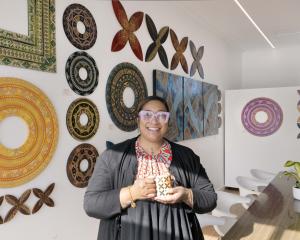
‘‘Jim Allen's News'', Mark Williams, Jim Allen and Mark Harvey (Blue Oyster Gallery)
‘‘Jim Allen's News'' is an exercise in recursion.
Curated - or more correctly created - by Mark Williams, Jim Allen and Mark Harvey, the work involved the re-creation of a 1976 piece of performance art by Allen, simply entitled News, in which the artist systematically destroys a newspaper.
In the exhibition, a replication of the original piece is presented on video, along with two responses to it by Mark Harvey, in which we see the performer repeatedly crumple and straighten out a newspaper, and wander around a fabric-lined enclosed space dressed in newspaper clothes.
In the latter piece, the increasing raggedness of the first video's paper is mirrored by the performer's increasingly manic action.
The gallery's other walls present Mark Williams' photographic documentation of the performance process.
The exhibition is thus partly a documentation of a performance, in response to a performance, which was in itself a response to the often non-impartial documentation in newspapers of actual events.
We are faced with the question of whether action can ever be precisely recorded, or whether all documentation becomes a case of Chinese whispers.
With this review, I am adding to the recursion by documenting and commenting on the whole process.
It would be satisfyingly fitting if this review itself eventually became the subject of yet another iteration of performance.

‘‘Within the White Frame'', Baden French (Moray Gallery)
The haze and open space of the Mackenzie basin has been captured in a series of acrylic paintings by Baden French, now showing at Moray Gallery.
The images are a mix of plein air works and works relying on the artist's photographic record of his trips to the area.
The images are vibrant, with strong colours, and with dynamic brushwork which does not attempt to capture the scene realistically, but instead takes the form of post-impressionistic mood pieces.
The rich tones of the sky, land and lakes hint at the environment, with bushes and trees loosely painted with bold angular strokes.
The scene is thus rendered in intense blocks of colour, detailed as much by the thickness of the applied paint as by the subtle tonal variations which go to make up those blocks.
Several of the pieces form pairs showing the same scene, presented in different light or with greater or less freedom of the brush.
These works, when compared, tell a considerable amount about the artist's eye for the land and his methods of capturing it.
Perhaps the most surprising feature of these paintings is that they are in acrylic; the colour, technique, and textures of the images give the strong suggestion of oil painting.
The resulting pieces are deeply evocative of the landscape of the inland South.

‘‘Beyond the Anti Fashion Manifesto'', Desi Liversage (Mint Gallery)
In her latest exhibition of embroidered art at Mint, Desi Liversage takes her cue from an Anti-Fashion Manifesto by writer Li Edelkoort.
In this manifesto, Edelkoort predicts that fashion is facing a crisis, both existentially and ecologically.
The economic cost of producing new and ever more outlandish styles, in terms of use of raw materials and pollution from the industrial process, and also in terms of the increasing turnaround from cutting-edge to passe, is leading to an industry in danger of disappearing up its own backside, and taking the environment with it.
In response to this, Liversage presents a series of reworked clothes, recycling and restitching to create something new and strange yet humble and non-toxic.
A series of dresses, waistcoats, and hats has been embellished with spiralling spiderweb patterns, runes, and matrices of sewn thread, the individual motifs becoming a secret symbolic language for the creator.
Two items, which were clearly beyond repair as actual clothes, have been reimagined as non-functioning artworks, hanging loosely within frames and stitched into new forms in rainbow colours and solid black respectively.
In creating these works from faded, formerly trendy clothes, the artist has rescued items which would have been bound for the landfill, breathing new life into them as works of fashionable anti-fashion.
-by James Dignan












